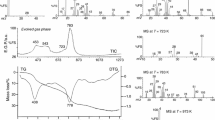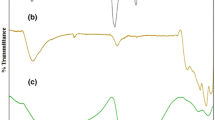Abstract
Zirconium n-propoxide Zr(OPrn)4 has been chemically modified by 1,3-propanediol and 1,3-butanediol with molar ratio r=0.5, 1 and 2. The properties of the hybrid organic-inorganic materials obtained after drying at 100°C for 24 hours have been measured by thermal analysis, X-ray diffraction, infra-red spectroscopy and 13C NMR with cross-polarisation at magic angle spinning. Chemical modification of the zirconium precursor at a molecular level has been clearly detected, with a bridging coordination mode for both diols. If the coordination mode of the diols cannot be changed by increasing the carbon chain length, it was found using 13C CP MAS NMR that the local order is much more well-defined when the reactivity of both OH groups are not the same. Thus, using 1,3-butanediol which has a primary and a secondary OH group, it is possible to obtain after complete modification (r=2) a highly homogeneous hybrid polymer which transforms directly into tetragonal zirconia below 400°C. With other diols (1,2-ethanediol and 1,3-propanediol), the hybrid materials transform into tetragonal zirconia above 400°C through a decomposition process involving several steps. Then playing with the carbon chain length and/or the steric hindrance around the OH groups provides an easy way to monitor the ultrastructure of these hybrid materials, and allows a better control of the gel → oxide transformation.
Similar content being viewed by others
References
J. Chaibi, M. Henry, H. Zarrouk, N. Gharbi, and J. Livage, J. Non-Cryst. Solids, 170, 1 (1994).
M. Chatry, M. Henry, M. In, C. Sanchez, and J. Livage, J. Sol-Gel Sci. Technology, 1, 233 (1994).
D.C. Bradley, R.C. Mehrotra, and D.P. Gaur, Metal Alkoxides, (Academic Press, London, 1978), p. 183.
R.M. Laine, K.Y. Blohowiak, T.R. Robinson, M.L. Hoppe, P. Nardi, J. Kampf, and J. Uhm, Nature, 353, 642 (1991).
R.C. Mehrotra and R.P. Narain, Indian J. Chem., 5, 544 (1967).
U.B. Saxena, A.K. Rai et, and R.C. Mehrotra, Inorg. Chim. Acta, 7, 681 (1973).
D. Massiot, CRPHT CNRS, 45071 Orleans Cedex 2, France.
H.O. Kalinowski, S. Berger, and S. Braun, Carbon-13 NMR Spectroscopy (John Wiley and Sons, Chichester, 1988), p. 181.
Author information
Authors and Affiliations
Rights and permissions
About this article
Cite this article
Chaibi, J., Henry, M., Zarrouk, H. et al. Structural influence of the carbon chain length in hybrid materials obtained from zirconium n-propoxide and diols. J Sol-Gel Sci Technol 4, 217–223 (1995). https://doi.org/10.1007/BF00488376
Received:
Accepted:
Issue Date:
DOI: https://doi.org/10.1007/BF00488376




